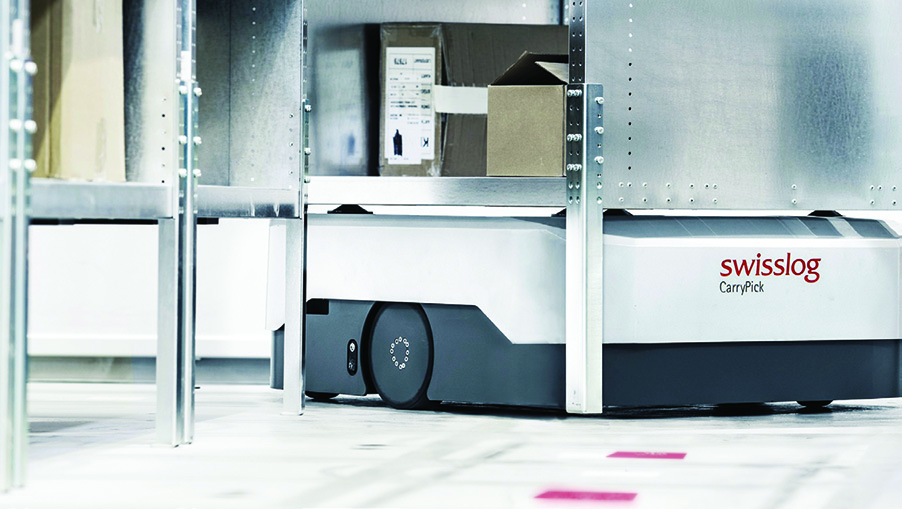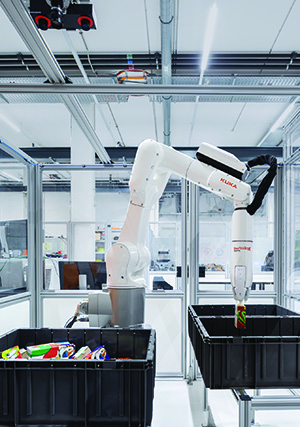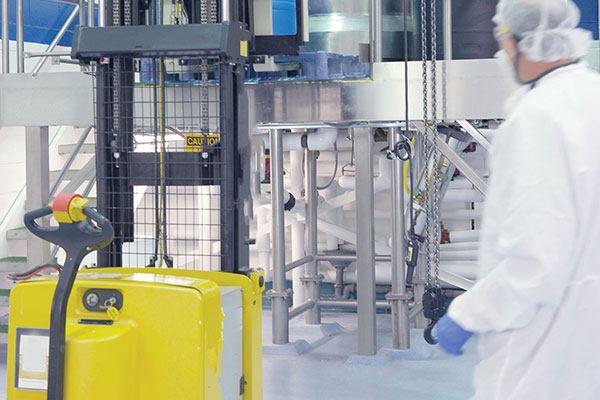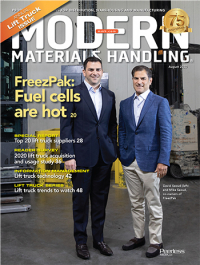Pharma Industry Trends and Solutions
New materials handling tools and approaches help this complex supply chain operate efficiently.
When it comes to the pharmaceutical supply chain, you’d be forgiven if your thoughts immediately went to track and trace. After all, with three years before the Drug Supply Chain Security Act (DSCSA) regulations officially kick in, industry professionals talk of little else—and compliance with these regulations drives many of the requirements for materials handling automation and its associated technologies.
As complicated as track, trace and serialization is, the materials handling side of the industry is evolving quickly, too. DSCSA is indeed a boon to smart technology like RFID, 2D bar codes, vision systems and robust software including warehouse management and execution systems, or the latest control tower software. Just as important, however, are new and advanced systems that keep the many elements of the pharmaceutical industry moving efficiently.
In fact, you could argue that materials handling in the pharma industry is even more challenging, when you consider the myriad products a distribution center must manage for a variety of customers. “The industry has huge complexity built into it,” says Bill Leber, director of business development for Swisslog Healthcare/Pharma. “You’ve got a wide variety of product lines, diversity in velocity and a huge SKU proliferation.”
Consider that the mix might include prescription and OTC pharmaceuticals, health and beauty products, big, slow-turn items like crutches, wheelchairs and other medical supplies, and everyday merchandise like candy and snack items. “In one DC, you could be looking at 140,000 SKUs,” says Leber. And according to Brian Sullivan, senior systems sales manager for healthcare solutions at KNAPP, “This is made more complicated by the complex reimbursement schemes that also affect industry profitability.”
The end customer line up is varied as well, and often includes wholesalers, retailers, hospitals, medical suppliers and even prisons. “Today, you’ve got the challenge of DSCSA on the way, reduced margins and shorter fulfillment times,” says Dematic’s Adam Brown, global market development director. “Most of the healthcare industry is purposefully segmented, but you do find some merged operations.”
Further complicating matters is the fact that, in spite of customer desires to reduce SKU counts, most pharmaceutical DCs need a fair share of customization. “If a supply chain manager has a surgeon who wants you to supply him with a certain type of suture, you’re not going to tell him no,” adds Leber. “Hospitals can’t stock everything, so they depend on DCs to re-supply them on a continual basis.”
Finally, the pandemic has had an impact on the industry as well. “Covid has amped everything up five-fold,” says Leber. “It has made automation even more valuable, because managing people on a floor is that much more difficult.”
Maintaining social distance on the floor, along with getting new or temporary employees up to speed quickly, means that quick-to-learn systems are essential. A screen that directs a worker with little training has less impact on productivity.
All of the above leads to the need for advanced materials handling systems. Tools like robotics, A-frame technology, automated storage and retrieval systems (AS/RS) and shuttle systems are all part and parcel to moving the varied mix of products out the door.

Smart picking
Ron May, senior consultant at Lucas Systems—whose customers include wholesale distributors like Medline and Owens and Minor, pharmacy/retailers such as CVS, and hospital networks like Baptist Health—often works with customers to strategize the most efficient way to pick at varying velocities. “No one technology can address the universe of complexity,” May says. “So, we first walk through a high-level overview of how demand for items is generated, how they accumulate orders and then slice and dice those transactions into groups,” he explains. “We look for pain points and understand how the business may fluctuate.”
For instance, a customer with a high-velocity item may bring a pallet to a putwall rather than send a picker to the same slot over and over during a shift. “If you’re picking to 200 stores, you bring a pallet of the product to the rack and pick however many of them you need into each bin,” he says
 As the technology matures, robotics is increasingly becoming part of the materials handling solution in the pharmaceutical industry, says Tom Galluzzo, CEO and founder of IAM Robotics. This is particularly true on the e-commerce side of the business. “Classic replenishment approaches don’t work well for e-commerce,” he says. “These customers want a supply chain that is robust, autonomous and leverages the latest technology to maximize flexibility.”
As the technology matures, robotics is increasingly becoming part of the materials handling solution in the pharmaceutical industry, says Tom Galluzzo, CEO and founder of IAM Robotics. This is particularly true on the e-commerce side of the business. “Classic replenishment approaches don’t work well for e-commerce,” he says. “These customers want a supply chain that is robust, autonomous and leverages the latest technology to maximize flexibility.”
This has especially been the case throughout the pandemic, Galluzzo adds. “There’s been increased demand for health items during the crisis and also for name brands on the merchandise side,” he explains. “Robots find their place here because they support flexibility.”
One particularly good application for robotics can be slow-moving items. IAM recently worked with a major pharmaceutical distributor struggling with slow-moving items clogging their automation. Totes filled with outgoing products hit a bottleneck point on the conveyors, diminishing overall throughput.
The distributor pulled out the slow movers from the high-speed system and moved them to a long-tail automation zone. IAM’s Swift robots pulled the slow movers from the conveyor, allowing the faster items to move through without a bottleneck. This led to a 15% increase in automation capacity.
AI-enabled robots
KNAPP, which has focused on the healthcare vertical since its inception in the 1950s, now provides a number of the most forward-looking solutions to the pharmaceutical industry, including artificial intelligence (AI)-enabled robots. “Transportation robots are one thing, but automating order picking is far more difficult,” says Sullivan. “We’re offering AI-enabled robots with a Cloud-based solution that leverage the latest software, vision systems, grippers and AI to build SKU databases automatically; accelerating the time it takes to bring a robot online, and raising the number of items that can be handled by order picking robots to more than 90%—while using Cloud technology to share this data in a network.”
Because HIPPA must come into play in pharmaceuticals, the AI is not presenting customer data—but does enable sharing of SKU-handling insights, including shape, weight and size knowledge, says Sullivan. “The system sees a shape, understands it and directs the robot to pick it,” he says. “As companies add items, the AI learns and stores this data in the Cloud. The end result is that each of the robots can pick at a minimum the same rate as a human being and often faster, some at up to 1,000 lines an hour or more.”
KNAPP also does a fair share of marrying up robots with human-staffed workstations, Sullivan says. “Shuttle systems and software can sequence orders and items with human-run stations,” he explains.
Even in cases where SKUs are large or oddly shaped, or slow movers, robots are finding a rapidly increasing role today. Sullivan says that with some of KNAPP’s designs, robots are able to manage 90% or more of the handling, turning it over to humans when encountering only the most difficult of sizes or shapes.
Goods-to-person
Bringing products to the person, rather than the other way around, is key in the pharmaceutical industry’s fast-moving segments, notes Dematic’s Brown. High-density storage technologies, such as shuttle systems and bot-enabled solutions such as AutoStore and OPEX are ideal for small items, and can fit four times the inventory in the same space you use for conventional storage. “There are tons of options to choose from when it comes to efficient goods-to-person operations,” says Brown.
KNAPP, too, frequently designs solutions with goods-to-person in mind for this industry. “Designing automation for this sector is complicated and typically requires awareness of regulatory requirements, process optimization and specific automation designed for the sector,” Sullivan says. “Cosmetics requires a different approach from pharmaceuticals, which will require a different approach from general merchandise.”
Surges to any and all of these areas will require flexibility and agility. Sullivan says that for cosmetics, he generally points customers to A-frame solutions for cosmetics order selection and then a shuttle for core warehouse operations. At one of its pharmaceutical customer sites, for instance, KNAPP supplied a fully automated shuttle system feeding order selection zones tailored to different product characteristics and order volumes, including an A-frame combined with RF terminals, goods-to-person picking stations and fully automated order selection robots.
The challenges in handling materials in the pharmaceutical industry are many, from serialization to expiration dates, temperature control and wide size variation. The good news is that materials handling solutions continue to evolve along with the industry, providing unique solutions for faster, more efficient operations. “We can now dial up and dial down systems to fit a customer’s unique make up,” says May. “We can combine historical knowledge from a wide variety of industries and pollinate good ideas to meet the challenges.”
Companies mentioned in this article:

Article Topics
Inventory & Picking News & Resources
Manhattan Associates selects TeamViewer as partner for warehouse vision picking Consultant and industry leader John M. Hill passes on at age 86 Siemens, Universal Robots, and Zivid partner to unveil smart robotic picking solution AI-based inventory monitoring solution provider Gather AI raises $17 million NRF 2024 retail sales forecast calls for growth Swisslog gives live demonstration of ItemPiQ latest evolution Cimcorp automates fresh food distribution with flexible storage, order picking solutions More Inventory & PickingLatest in Materials Handling
Beckhoff USA opens new office in Austin, Texas Manhattan Associates selects TeamViewer as partner for warehouse vision picking ASME Foundation wins grant for technical workforce development The (Not So) Secret Weapons: How Key Cabinets and Asset Management Lockers Are Changing Supply Chain Operations MODEX C-Suite Interview with Harold Vanasse: The perfect blend of automation and sustainability Consultant and industry leader John M. Hill passes on at age 86 Registration open for Pack Expo International 2024 More Materials HandlingAbout the Author
Subscribe to Materials Handling Magazine

Find out what the world's most innovative companies are doing to improve productivity in their plants and distribution centers.
Start your FREE subscription today.
April 2024 Modern Materials Handling

Latest Resources












